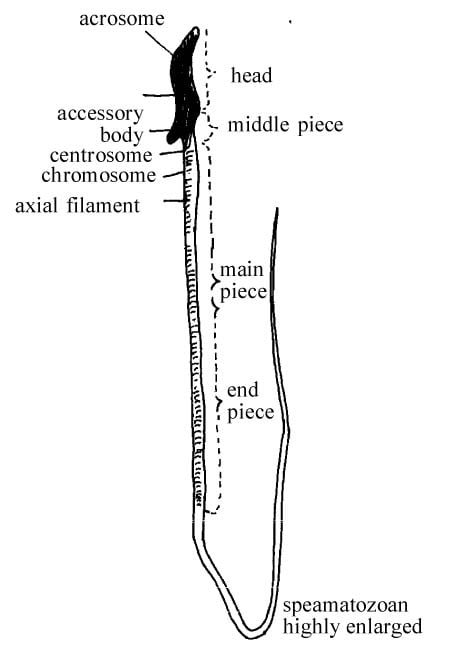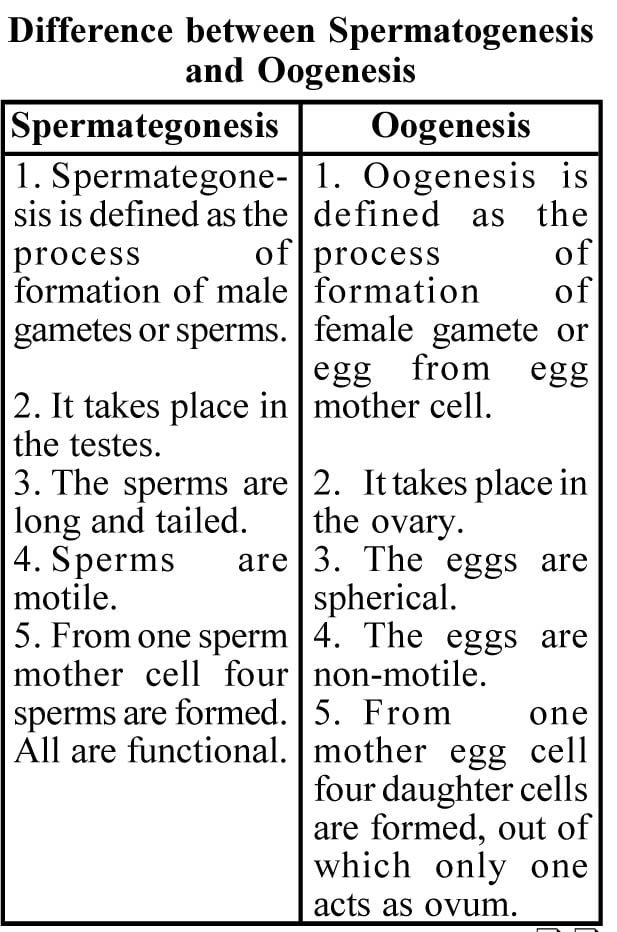Female reproductive cycles
Mammals are exclusively sexually breeder. The reproduction depends upon certain changes in reproductive organs and behaviour. The changes mainly consists of the sexual cycles (especially the female). There are two types of cycles exhibited by the mammals—
(1) Menstrual cycle : Normally this cycle repeats after every 28 days. After 28 days the ova are released from the ovary of woman. During this particular period many structural and histological changes are observed in the ovary, uterus, mammary glands and sexual behaviour along with the changes in the reproductive hormonal level. These changes are collectively known as menstruation or menstrual cycle.
This cycly is present in primates.
Gametogenesis : It is the process of the formation of the gametes in the reproductive organs of the parents and the process of their development.
Fertilisation : Fertilisation is the process of the fusion of male and female gametes.
Cleavage : It represents a series of successive and rapid mitotic divisions in the zygote forming a blastula.
Gastrulation : The gastrulation is a process in which there occurs large-scale movement and rearrangement of cells of blastula, thereby leading to the formation of three germinal layers.
Morphogenesis : It is the process of acquiring the specific shape and form of the embryo.
Hermaphrodite : Animals are said to be hermaphrodite if both male and female gonads are present in the same individual.
Parthenogenesis : It is the process of development of an egg without fertilisation by a sperm.
Gonads : The gametes (sperms and ova) are produced in special reproductive organs, collectively known as gonads.
Oogenesis : The process of the formation, development and maturation of ovum is kinown as oogenesis.
Embryo : It is the product of fertilised egg which gives rise to the individual.
Microlectihal eggs : These are the eggs which contain a moderate amount of yolk.
Macrolecithal eggs : These are the eggs which contain enormous quantities of yolk. All living beings produce daughter individuals and thus the continuity of their race is maintained. The animals may be as big as an elephant or whale but the embroyonic development of all animals and plants starts from a sigle cell, the fertillzed egg. As it divides during development, cells become differentiated in structure and function. These differences in the life of the individual are retained throughout. A developing organism is known as Embryo. This embryo now divides mitotically without genetic modifications of any type and develops into different types of tissues and organs which may have cells no matter how different in structure and function, but genetically they all remain identical in an inividual.
A very significant event that takes place before fertillzation is the formation of the sperms and eggs. They fuse to form zygote. The formation of gametes is known as Gemetogenesis and the phenomenon of fusion of the dissimilar gamestes is called fertilisation. Gametogenesis is the process by which the diploid germ cells give rise to haploid gametes i.e. sperms in males and eggs in the females. Meiosis is an integral part in the gamete formation by which the alleles are rearranged on the chromosomes which are reduced to haploid number. If a diploid nucleus contains only two pairs of chromosomes, the haploid nucleus will contain only two chromosomes rather than the original four. The Gametogenesis can be differentiated as Spermatogenesis when only the sperms are produced and oogenesis when the ova are produced.
Spermatogenesis : A sperm is very important cell and develops the paternal set of chromosomes to the egg. It also trigers embryonic development by breaking the arrest of the mature oocyte. In the testes of higher animals, the sperms are produced in the seminiferous tubules. They develop from germinal epithelium and some of the cells of germinal epithelium divide again and again mitotically to produce spermatogonia. These are the Spermatogonia cells and are diploid. These Spermatogonia now grow in size and are termed as spermatocytes. Now the meiotic division takes place. Each spermatocyte forms two secondary spermatocytes which immediately undergo second meiotic division and produce spermatids, the second meiotic division is only an equational division.
In some species e.g. human males, the spermatocytes are continually replaced as they develop into sperms. This means that once the spermatogenesis starts, i.e at the age of 12-14 years, it continues throughout the life. Although there is a great morphological difference among different animals, yet the sperms of many of them are remarkably similar in structure. They contain the basic three parts. The head containing the nucleus, the mid piece mitochondria, and the tail. The head is concerned with the fertilisation as the sperm head develops from the haploid nucleus. The chromatin of the nucleus is condensed as it carries only smaller basic proteins containing the DNA. Histone & nonhistone proteins are replaced and the other nuclear substance is eliminated. The cytoplasm is also very much reduced and all that remains in the sperm head as a cytoplasmic organelle is acrosome. The acrosome contains enzymes which break down the external wall of ova during fertilisation.
The middle piece provides energy and is put in use after the sperm penetrates the egg. The proximal centriole in the neck plays a role in the first division of the fertilized ovum. The distil centriole attaches the long tail.

The tail is a typical eukaryotic flagellum with a typical micro tubule system of 9+2. The mitochondria gives energy to the tail for movement. Oogensis : The eggs cells originate in the embryonic development of an animal from a cell line which migrate with the developing female sex organs. These cells divide by mitosis and produce potential egg cells. The maturation of these cells into mature eggs is called oogenesis. The egg cells called oocytes are formed from oogonia which are formed from the germinal epithelium. The egg mother cells of the germinal epithelium undergo multiplication and form the oogonium. Only a few of these oocytes finally develop into ova and the remaining oocytes become follicle cells and they provide nourishment to the developing ovum. In human beings all the oocyltes required for the total reproduction period are already present at the time of birth in a female but they only grow until 13-14 years of age. Each primary oocyte undergoes two divisions. The first meiotic division produces two daughter cells of unequal size with haploid number of chromosomes. The second division of the oocyte produces again a large cell called egg and a small polor body. The polar body in the second division producess two daughter bodies. Thus four cells develop from one oogonium. Out of these four cells, only one large cell called ovum is functional and other three die. During the meiotic divison, the chromosomes in the nucleus of oocyle transcribe large amounts of RNA, the mRNA which is active immediately and directs the synthesis of large amounts of enzymes and ribosomal proteins. All other proteins are stored in the yolk.
Structure of an ovum : An ovum of all animals is single celled and is surrounded by the vitalline membrane. On its way to the oviduct and uterus, the amphibian egg may secrete a jelly around, layers of albumen, yolk and calcarious shell in a chick. The nucleus is found in the pigmented portion and is termed as the animal hemisphere. The white part of the yolk is called the vegetal hemisphere.
Types of eggs : All egg cells have the same structure and normally contain yolk lipids and glycogen etc. But these eggs can be differentiated according to the quantity of yolk present.
1. Microlecithal eggs : These are the eggs which contain very less amount of yolk e.g. eggs of sea urchins. They are also called oligolecithal eggs.
2. Alecithal eggs : These are the eggs with no yolk and are found in mammals.
3. Mesolecithal eggs : Frogs, toad etc. have the eggs in which moderate amount of yolk is present.
4. Macrolecithal eggs : These eggs have large amounts of yolk in them e.g. birds, reptiles and insects. These eggs are also called polylecithal eggs. If the yolk is evenly distributed throughout, they are called the isolecithal or homolecithal eggs. The eggs in which yolk is concentrated in the vegetal hemisphere and the nucelus is displaced towards the animal hemisphere are called the telolecithal eggs. In insects the yolk is concentrated in the centre and such position of yolk is called centrolecithal.




